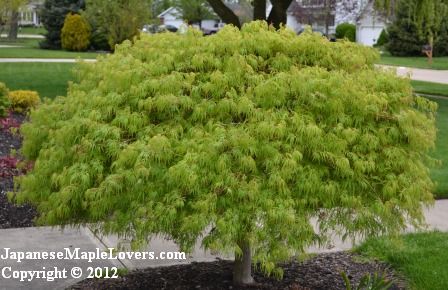
I’ve had this beautiful Laceleaf Weeping Japanese Maple in my landscape for years. The variety is ‘Waterfall’. But eventually it out grew the bed that it was in. It was encroaching the sidewalk on two sides. Pruning it to keep it from blocking the walkway would have ruined the shape of the tree.
Then I had a bed with huge stump in it that could not be ground because underground power lines ran directly under the stump. They also ran very close to this tree as well which made moving it a bit tricky.
This is truly a beautiful tree so moving it to a bigger bed was the best option.
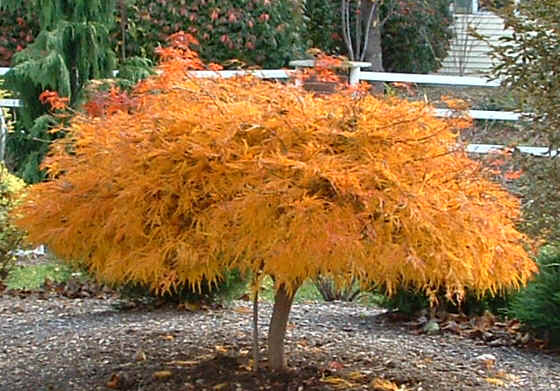
Isn’t the fall color amazing?
Now . . . digging a tree like this is no easy task. Japanese maple truly have hard wood and that goes for the roots as well as the branches of the tree. The roots are very hard to cut and you need a really good digging spade that is razor sharp (This is the nursery spade I recommend [Amazon]. And you also need a great deal of stamina. Something I’m a little short on at my age so I hired a landscaping crew to move this tree as well as two other similar, but smaller trees for me.
It’s frustrating not being able to do the things that I did with ease a few years ago, but it is what it is. Duston and I moved a tree very similar to this one a couple of years ago and it was no easy task. I knew better than tackle this project since it actually involved digging a total of four trees, two really big hydrangeas and moving a great deal of topsoil.
Because of the power, phone and cable lines that run very near this tree the root ball size is a bit smaller than it could be, but I’m not concerned, I’m sure the tree will be fine. The standard is 11″ of root ball diameter for every one inch of tree caliper. Tree Caliper is the diameter of the stem, measured six inches from the soil level.
Really, really important!!!
It’s important to point out that you can only do this when the tree is completely dormant. I waited weeks for a good hard freeze before this job could be done. We didn’t get that hard freeze until November 21st this year. We did this job on the 24th of November. Or should I say Fransciso and his crew did this job.
There’s a lot going on, things to point out in the above photo.
- The guy on the right with the spade is Francisco. I love that fact that Francisco is on the job, working right along side his crew. He reminds me of a younger version of myself. I’ve known Francisco for along time. When I first met him he was working at a nursery loading my truck back in my landscaping days. Today he has a very successful landscaping contracting business.
- Notice the red and orange lines painted on the ground. Anytime you are digging anywhere that there might be underground utilities you need to call the “Call Before You Dig” number in your area and have them come out and locate and mark the utilities for you.
- In this photo you can see Two Jackson Wheelbarrows. If you know anything about me at all, you know that I insist on using the best tools on the market and a Jackson Wheelbarrow is one of the best you can get. In my Wheelbarrow Tips and Tricks article and video I tell you why.
- The root ball is taking shape. Notice how the guys dug around the tree and now they are working their digging spades under the root ball. They are not beating up the root ball, they are not rocking the tree back and forth. Up to this point the tree has not been touched, not moved in slightest way. They are literally “carving” a root ball around the soil and roots that they intend to save. This truly is an art.
Digging a root ball like this is an art. It’s not that difficult, anybody can do it, but most lack the one tool that you need to do so. A really good digging spade. A good digging spade sells for $89 to $130 (this is the nursery spade I recommend [Amazon]. If you paid less, you don’t have a true digging spade.
Unfortunately I had to run out for a bit and didn’t get photos of Fransisco and crew moving this tree once it was dug. So I am going to stick in a video that Duston and I did a couple of years ago and show you how to handle balled trees.
This video is all about digging and moving a live Christmas tree. Lots of good info in this movie.
This photo does not do this landscape planting justice but I promise to add better photos once these plants leaf out in the spring. This bed had a huge problem. There is a giant tree stump in this bed that could not be ground because of the power lines that run underneath it. So I had Francisco and his guys transplant into this bed three different Laceleaf Weeping Japanese maples, two really big Endless Summer Hydrangeas and a number of assorted Coral Bells.
The tree stump is actually front of the biggest Japanese maple and slightly covered with soil. And I do mean slightly because it is actually pretty high.
The Laceleaf Japanese Maples are all different. The bigger one in the center is the ‘Waterfall’ that you see at the top of this page, the smaller one to the right is a red variety, not sure I have the tag for it but it’s very much like Crimson Queen, might be Crimson Queen but I don’t remember. I had about 20 in one bed and some of the tags blew off. Not a good thing Mike!
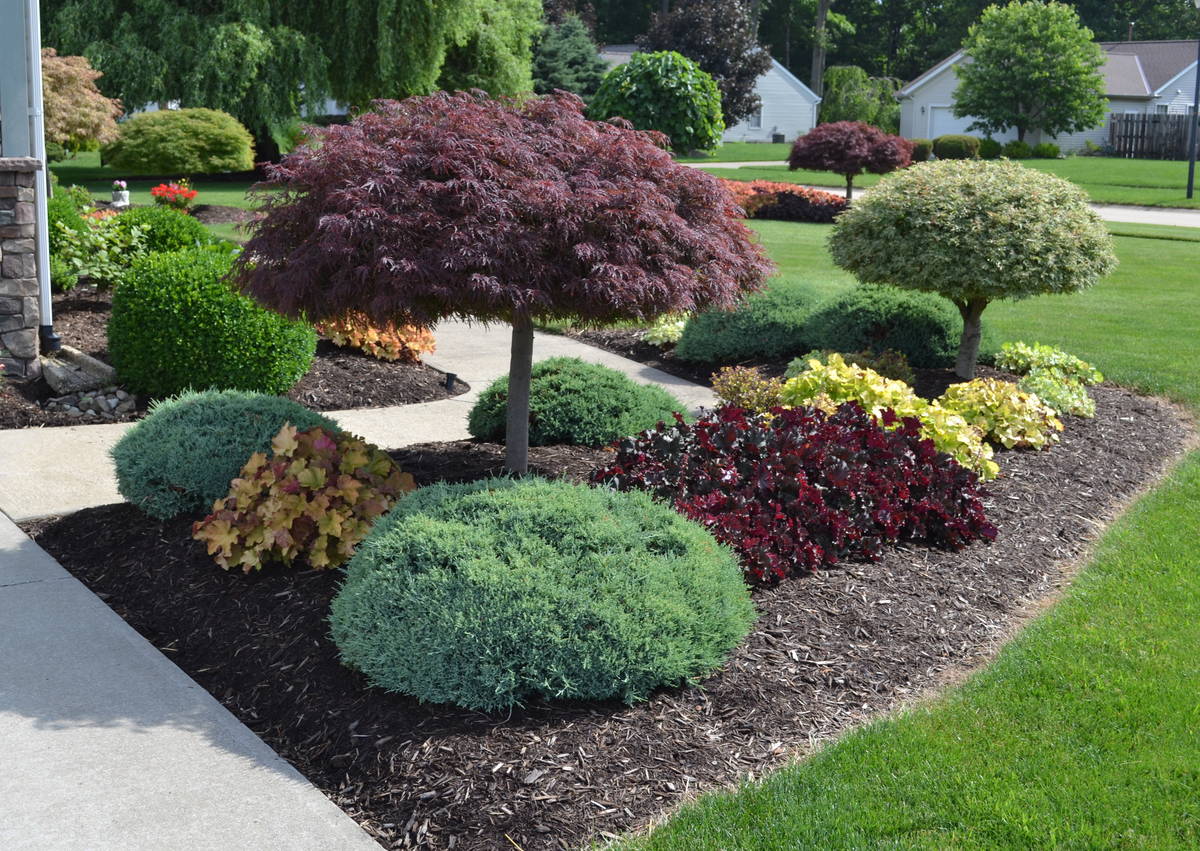
The red one will look like this one. Or this one that actually has Coral Bells planted around it.
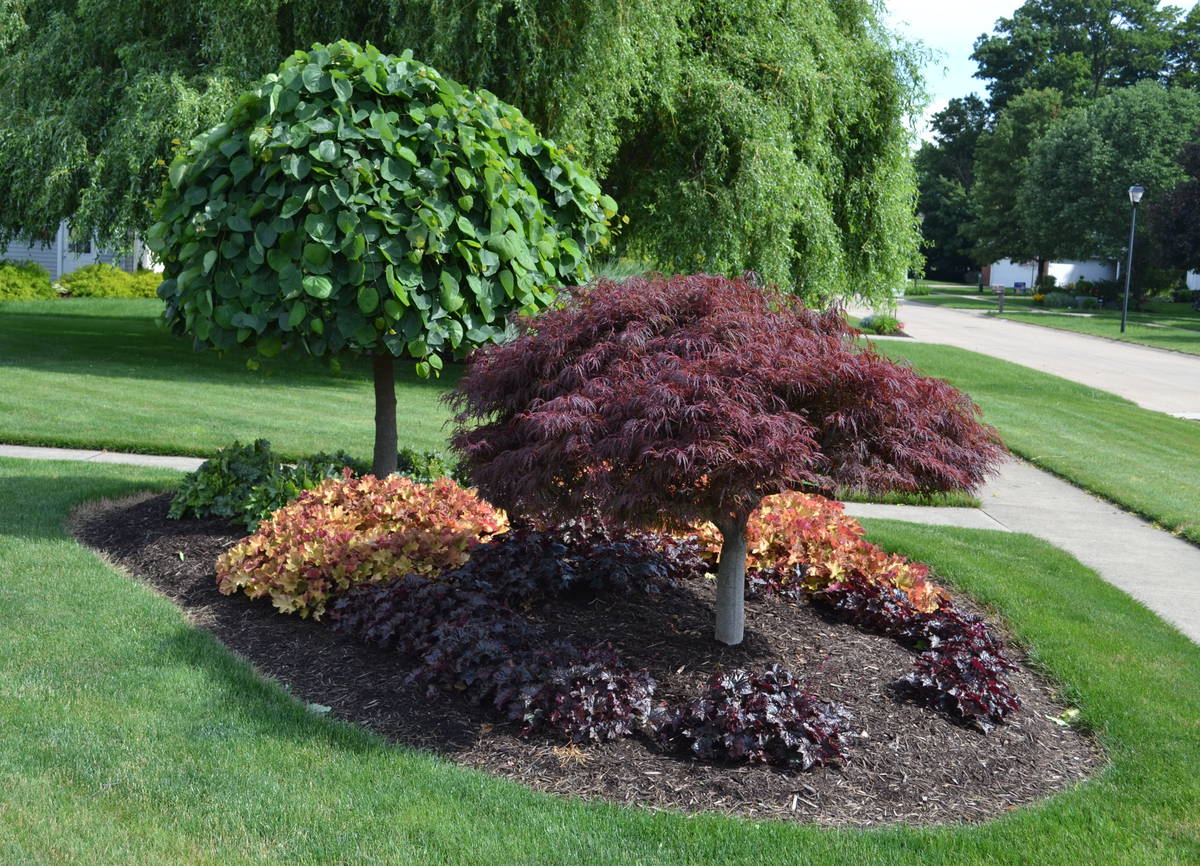
The third one, the one on the right is a variegated variety called Goshiki Shidare. This is what the Goshiki Shadaire looks like.

I can’t wait until spring! I’m excited as a kid in a candy store to see all three of these beautiful Japanese maples in full leaf in this new bed that has been a big pain in the butt and pretty much an eye sore for way too long. The bed is near the sidewalk and we get a lot of people walking in our neighborhood so I’m excited to show this planting off.
And I want to give a big “Thank You” to my good friend Francisco for helping me get this project done.
Francisco is a great guy. He has done a great deal of work in my neighborhood and he does work all over Lake County, Ohio. If you live in the area and need a good landscaper, call Francisco!

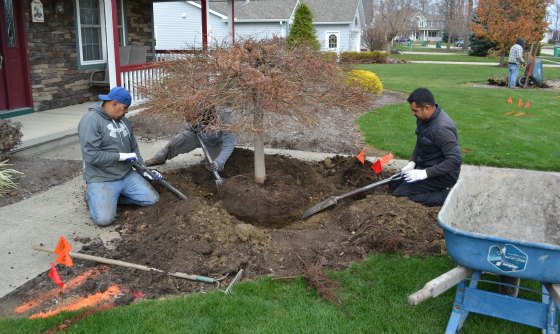
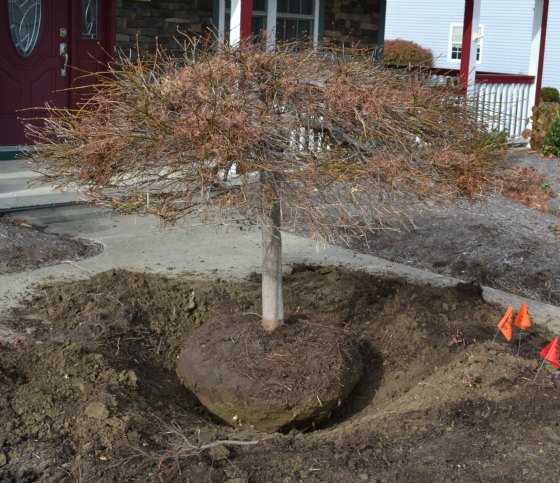
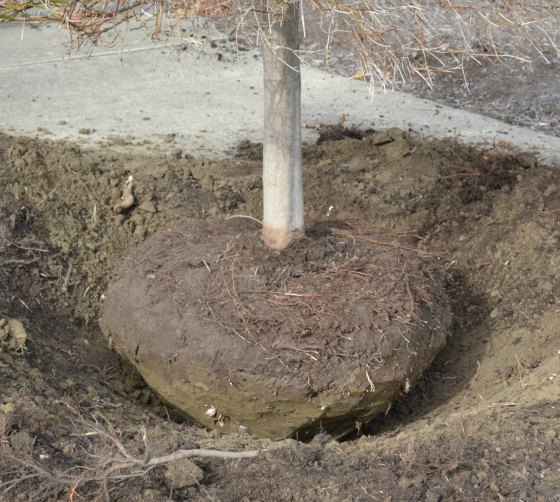
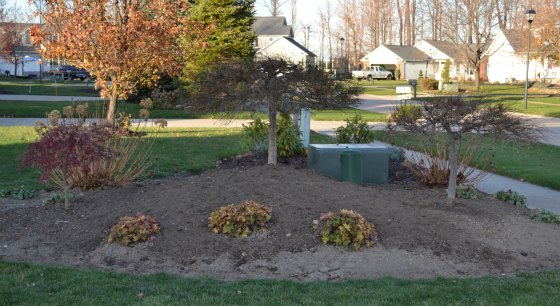

I have a lace leaf weeping Japanese maple that is planted in a corner of my front yard. It is growing over the driveway and an adjacent sidewalk. The two sides that face the yard are a little bare. Would it be possible to dig around the root ball and turn the tree 180 degrees without damaging the roots or the tree itself?
I live in central Ohio.
Sandy,
If you did it after Thanksgiving it would probably fine.
I just have a question, I am getting ready to plant an orangeola laceleaf maple (5 gallon) in my backyard. I am really afraid that I am going to plant it in the wrong area. It says sun, but afternoon shade and protection from wind. We have some type of wind daily here in Carson City, Nevada. I want to plant it by my fence line but don’t know if that is enough wind protection and also it gets some afternoon sun for a few hours. Can you give me any advice? Thank-you!
Janice,
I would think the fence would minimize the wind. Some sun is what it needs. Don’t plant it too deep, don’t plant it in a wet area and don’t fertilize it. If the ground is clay plant it a bit high so excess water can run away from the tree. But still water as needed.
What is tree with the green leafs planted in second picture
Tom,
I think you’re asking about the weeping nootka cypress in the background?
We’re about to transplant a similar Japanese maple, maybe a little older. We’re curious as to how the transplanted tree survived the first year and subsequent year. Don’t know you had a post that covered this already. Thanks! This is a great post.
Tom,
The tree did fantastic and still is doing great.
Hi Mike,
We have a 10′ Japanese maple (unnamed green variety) that we dug up as a seedling in 1998 and put in a pot. It’s lived its entire life in a pot and is now in a half whisky barrel. We finally have a place for it in our yard. Can I plant a tree this old and large? I would of course wait until the fall when it is dormant again. We live in Portland OR.
Ann,
Yes you can. If you wait until it’s dormant make sure you cut some of the circling roots before you plant so it can get established in it’s new home. Do not plant it in a wet spot and I wouldn’t fertilize it unless you use something organic.
Hello Mike,
I live just outside of Portland Oregon and have a red lace leaf maple that seemed to lose lots of its leaves early last fall. I was concerned that something was wrong at the roots since it had nothing unusual on the leaves. We never had a real freeze this year so the intended move has not happened and now it’s april and the remaining healthy parts of the tree (about 60%) are leafing out.
Should I attempt a move at this late date? Im worried that whatever is wrong underneath will kill the whole tree if I don’t take a look and change it’s soil….
Thanks,
Wendi
Wendi,
I suspect that it is now too late to move the tree. Once they start making leaves any severing of roots could easily kill the tree. As long as the soil is not too wet, the tree should be fine. Really, only planting too deep and too much moisture around the roots are the only things that go wrong below the soil level.
Hi Mike
This is all great information and eases my
I am in Central Ohio needing to transplant a 4 yr Laceleaf Dwarf Japanese Maple but am terrified I may lose it. My dilemma is it cannot be replanted until Spring likely past the dormant stages.. Is it best to stage it in burlap or container through the winter months until the space becomes available early April. It should be small enough for a #25 potting container but worry about protecting the roots during a deep freeze.
Thanks
Matt
Matt,
Here in northern Ohio we typically can dig right up to the 3rd week of April, although there is no guarantee of that. You? Late March, early April at the latest. But you should be fine no matter when you dig it. I have at least one hundred in pots right now sitting on top of the ground, they’ll be fine. Burplap would be better, depending on the soil it might get too wet in the container.
Or dig it first chance you get, then heel it back into the hole it came out of until you’re ready to plant it. It won’t root back in that quickly.
I live in South Carolina, hot temperatures. I have been struggling for the last couple of months and wasted money purchasing a tree that does not fit the area in question, based on advice from a local landscape person. I need a nice tree that will not reach an extensive height in years to come, preferably no more than 6ft. I noticed that you have a lot of interesting landscaped gardens on your website and would like to know if you can help me make my front of the house flower bed very eye catching.. I would love to send you a picture of the area if you can provide me instructions of how to send a picture….please help.
Osmona,
I can’t review photos, I don’t see incoming email. We do however share photos in our members area. http://backyardgrowers.com/join
You can’t go wrong with a weeping Japanese maple for any garden.
Hi Mike, I am so glad I ran across your site. You are a wealth of info. I wanted to know if you could guide me a little. I have a blank slate of 1 acre with a small home on it. I am trying to figure out how to make my “spot” beautifull. I am really interested in knowing how long trees like these above (gorgeous!!!) and other fast growing tress that I can get going at my homeplace. Let me know if you can or direct me to where such a list may be compiled. I love the ornamental trees, dogwood, crape mytle in my area but would love to branch out from the norm. I live in the Eastern Shore of Virginia, that is Zone 8. Thank you for all your great help and inspiration, love the donkeys and BTW I am 53yo, I wanna see my labor come to fruition. Thanks, Suzie
Suzie,
This of course depends on where exactly in your yard you wish to plant trees that determine which tree is best. Rule #1. Be careful what you read online and in mail order ads. Many of the plants they feature are awesome, some not so much but they make them sound like a million bucks. An important point to consider is this; in my mind, and 45 years of experience, fast growing usually means low quality.
Trees like Japanese maples, especially rare Japanese maples are very slow growing which is why they carry the price tags that they do. Trees that are touted as growing 3′ a year? I’d run from that tree. The slower growing the plant, the higher it’s value. Not only in dollars, but in it’s appearance in your yard. So as you conduct your search, keep this in mind. I’d rather have one really beautiful Japanese maple than 1,000 hybrid poplar trees.
Excellent job done by a real pro. Your tree will never even know it was moved! In other words no transplant shock. Hopefully someone remembered to tag its north side so that it is oriented correctly.